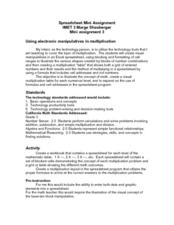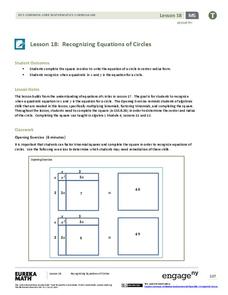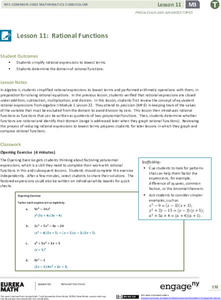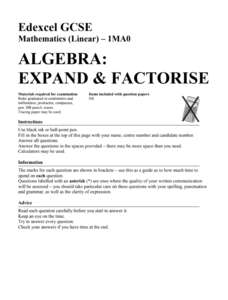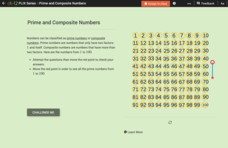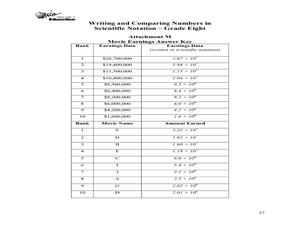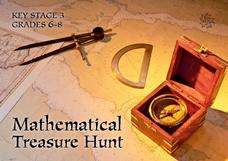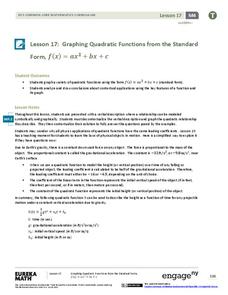Curated OER
Addition and Subtraction of Rational Expressions
In this adding and subtracting rational numbers worksheet, students add and subtract 20 sets of fractions with polynomial denominators. Students compute common denominators.
Curated OER
Using Electronic Manipulatives in Multiplication
Factor polynomials using electronic manipulatives. Your class will create a spreadsheet in excel and use it to multiply and perform basic operations and solve problems correctly. They create a visual to go along with each multiplication...
Curated OER
Factor Trees
In this factor trees worksheet, students make factor trees for 2 through 4 digit numbers. Students complete 20 factor trees for these numbers.
EngageNY
Recognizing Equations of Circles
What does completing the square have to do with circles? Math pupils use completing the square and other algebraic techniques to rewrite equations of circles in center-radius form. They then analyze equations of the form x^2 + y^2 + Ax +...
EngageNY
Solving Quadratic Equations by Completing the Square
Many learners find completing the square the preferred approach to solving quadratic equations. Class members combine their skills of using square roots to solve quadratics and completing the square. The resource incorporates a...
EngageNY
Rational Functions
Make a connection between rational expressions and rational functions. Pupils review simplifying and performing operations on rational expressions and recall what it means for two rational expressions to be equivalent based on their...
Curated OER
Using Factor Trees
In this math worksheet, students read about how to create a factor tree. Students use factor trees to determine the prime factors of 16 numbers.
Curated OER
Watch Your P's and Q's
Using your graphing calculator, find all the rational zeroes of a polynomials by using the Rational Zero Theorem. Divide polynomials using the Remainder Theorem and the Factor Theorem and then graph it to find the number of real roots.
Mathed Up!
Expand and Factorise
Expand and contract algebra. Using a video from a larger review series, pupils refresh their skills to factor algebraic expressions. They also use the distributive property to expand expressions on the learning exercise. Problems range...
CK-12 Foundation
Prime and Composite Numbers
Nine true or false, multiple-choice, and discussion questions make up an interactive designed to reinforce scholars' knowledge of prime and composite numbers. A number chart reveals every prime number through 100.
Curated OER
Factors Which Affect the Rate of Chemical Reactions
Students complete an experiment with Alka-Seltzer and reaction rates. They control the rate in which gases are allowed to escape. They test their predictions and observe what happens during the experiment.
Ohio Department of Education
Writing and Comparing Numbers in Scientific Notation-Grade Eight
Explore scientific notation in this mathematics lesson. Young mathematicians explore multiple representations of large number in scientific notation through the use of models, visual representation and expanded form. The lesson provided...
Curated OER
Composite and Prime Numbers
Young math whizzes determine if a number is prime or composite. They use counters to participate in activities that show prime and composite numbers.
Curated OER
Problem Solving
Give kids a few strategies to help them become amazing problem solvers. This presentation is intended to be used over a two-day period and presents several techniques or ways to solve word problems or multiplication problems by...
Curated OER
Split a Factor
Take the mystery out of multiplicaton with worksheets like this one. Learners find a mental math strategy for more difficult equations by splitting a factor, multiplying out the terms, and adding the products. An example explains this...
Scholastic
Study Jams! Greatest Common Factor
When one method isn't enough to teach GCF, try two! This interactive webpage introduces factors and the prime factor tree to find the greatest common factor of two numbers. After the lesson, have learners click to try the two examples...
Curated OER
Mathematical Treasure Hunt
The hunt is on! Young mathematicians follow clues and complete a series of ten math puzzles as they try to crack Dr. Integer's code and find the location of his hidden treasure.
Utah Education Network (UEN)
Expressions and Equations Part 1
Express your love of equations! Pupils first learn to write and simplify numerical and algebraic expressions. Then, create and solve two-step equations. The progression is a great way to introduce the concept slowly.
Inside Mathematics
Quadratic (2006)
Most problems can be solved using more than one method. A learning exercise includes just nine questions but many more ways to solve each. Scholars must graph, solve, and justify quadratic problems.
EngageNY
Graphing Quadratic Functions from the Standard Form
Use context to explain the importance of the key features of a graph. When context is introduced, the domain and range have meaning, which enhances understanding. Pupils use application questions to explore the key features of the graph...
EngageNY
Graphing Quadratic Functions from Factored Form
How do you graph a quadratic function efficiently? Explore graphing quadratic functions by writing in intercept form with a lesson that makes a strong connection to the symmetry of the graph and its key features before individuals write...
EngageNY
Modeling with Quadratic Functions (part 1)
Relevance is key! The resource applies quadratic modeling by incorporating application of physics and business. Pupils work through scenarios of projectile motion and revenue/profit relationships. By using the key features of the graph,...
Noyce Foundation
Miles of Tiles
Create number sentences and equations to solve geometric problems. Each activity in the series of five asks young mathematicians to consider different-sized tiles to build structures according to specific criteria. The first activities,...
Concord Consortium
Transformations-Diagnostic
Change the way you teach about rewriting expressions. A diagnostic task asks learners to transform expressions in different ways. Given two linear expressions and two quadratic expressions, they rewrite them into the indicated forms.

